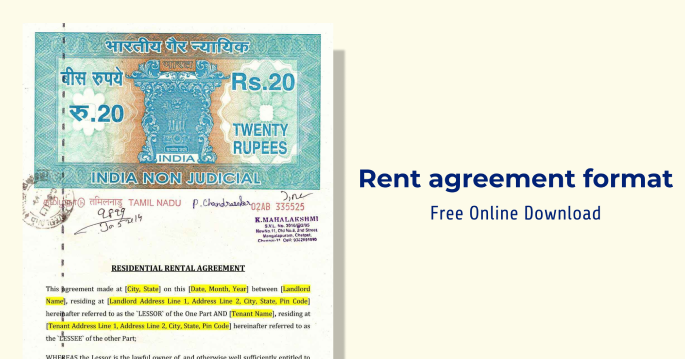
A rent agreement is a vital legal document that outlines the terms and conditions governing the relationship between a landlord and tenant during a tenancy. Ensuring a clear and comprehensive rental agreement format is essential to safeguard the interests of both parties involved.
In this blog post, we delve into the fundamental aspects of rental agreement formats in India. We explore the crucial components that should be included, different types of rental agreement formats, and offer insights on crafting a comprehensive format. Additionally, we provide information on online tools, real-life examples, and the importance of seeking professional advice.
What is a Rent Agreement?
A rental agreement is a legally binding contract between a landlord and a tenant. It outlines the terms and conditions of the tenancy, such as the rent amount, security deposit, lease duration, and responsibilities of both parties. A rental agreement is important for both landlords and tenants because it protects their respective interests.
For landlords, a rental agreement helps to ensure that they receive the rent on time and that the property is maintained in good condition. It also provides a legal framework for resolving disputes that may arise during the tenancy.
For tenants, a rental agreement helps to ensure that they have a right to occupy the property and that they are not taken advantage of by the landlord. It also provides a record of the terms and conditions of the tenancy, which can be helpful if there is a dispute.
Key Components of a Rental Agreement Format
A rental agreement format is a template that can be used to create a rental agreement. A rental agreement format usually comprises the following sections…
- Parties involved: The names and contact information of the landlord and tenant.
- Property details: The address of the property, the type of property (e.g., house, apartment, commercial space), and the number of bedrooms and bathrooms.
- Rent details: The amount of rent, the due date, and the payment method.
- Security deposit: The amount of the security deposit, how it will be used, and when it will be returned.
- Duration of the lease: The start date and end date of the lease.
- Renewal and termination clauses: The terms for renewing the lease and terminating the lease early.
- Maintenance and repair responsibilities: Who is responsible for repairs and maintenance of the property.
- Rules for utilities, amenities, and common areas: The rules for using utilities, amenities, and common areas in the property.
- Other specific clauses: Any other clauses that are relevant to the tenancy, such as pet policies or smoking policies.
Essential Components of a Rental Agreement Format
The following are some of the essential components that should be included in a rental agreement format:
- Clear and concise language: Ensure the rental agreement is written in clear and straightforward language for both parties to understand.
- Complete and accurate information: The rental agreement should include complete and accurate information about the property, the rent, the security deposit, the lease duration, and other relevant terms.
- Legally binding clauses: The rental agreement should include legally binding clauses that protect the interests of both parties.
- Signatures of all parties: The rental agreement should be signed by both the landlord and the tenant.
Different Types of Rental Agreement Formats
Various rental agreement formats exist, each with its own pros and cons. The type of rental agreement format that is best for a particular tenancy will depend on the specific circumstances.
- Fixed-term leases: Fixed-term leases are the most common type of rental agreement format. They specify a fixed lease duration, such as one year or two years. At the end of the lease term, the tenant has the option to renew the lease or move out.
- Month-to-month leases: Month-to-month leases are less common than fixed-term leases. They do not specify a lease duration, and either party can terminate the lease with one month’s notice. Month-to-month leases are often used for short-term tenancies.
- Subletting agreements: Subletting agreements allow a tenant to rent out their property to another person. The subletting agreement should be in writing and should specify the terms of the sublet, such as the rent amount and the duration of the sublet.
Creating a Clear and Comprehensive Format
Here are some tips for creating a clear and comprehensive rental agreement format:
- Employ language that is clear and to the point.
- Include all relevant terms and conditions.
- Get legal advice if necessary.
- Have the rental agreement reviewed by a lawyer.
- Sign the rental agreement in front of a witness.
Adhering to Legal Regulations and Guidelines
It is important to adhere to legal regulations and guidelines when creating a rental agreement format. The specific legal requirements for rental agreement formats will vary depending on the state or city in India. However, there are some general guidelines that should be followed.
- Ensure the rental agreement is written and signed by both the landlord and the tenant.
- The rental agreement should include the name and address of the property, the names and contact information of the landlord and tenant, the rent amount, the security deposit amount, the lease duration, and the terms for renewing the lease and terminating the lease early.
- The rental agreement should also include clauses that address the following topics:
- Maintenance and repair responsibilities
- Rules for utilities, amenities, and common areas
- Pet policies
- Smoking policies
- Other relevant terms
It is important to get legal advice if there are any specific legal requirements that need to be considered when creating a rental agreement format. A lawyer can help to ensure that the rental agreement is legally binding and that it protects the interests of both parties.
Customizing the Format for Specific Situations
The rental agreement format can be customized to fit the specific circumstances of the tenancy. For example, a rental agreement for a furnished property will need to include different terms than a rental agreement for an unfurnished property. Similarly, a rental agreement for a commercial property will need to include different terms than a rental agreement for a residential property.
Consider the unique circumstances of the tenancy when customizing the rental agreement format. This will help to ensure that the rental agreement is fair and equitable for both parties.
Online Tools and Templates for Rental Agreement Formats
Several online tools and templates are available for crafting a rental agreement format. These tools and templates can be a helpful resource for landlords and tenants who do not want to create their own rental agreements from scratch.
One of the most popular online tools and templates for rental agreement formats is RentOk app
RentOk: RentOk is an app that makes it easy to create a free rental agreement with the eKYC of a tenant. The app is available on Google Playstore
Reviewing Real-life Examples
Examining real-life examples of rental agreement formats can be beneficial before creating your own. This can give you a good idea of the types of terms and conditions that are typically included in a rental agreement.
However, it is important to remember that every tenancy is different. The terms and conditions of a rental agreement should be tailored to the specific circumstances of the tenancy. It is not a good idea to simply copy and paste the terms and conditions from another rental agreement.
Seeking Professional Advice
For any queries about rental agreement formats, it’s advisable to consult with a lawyer for professional guidance. A lawyer can help you to create a rental agreement that is legally compliant and that protects the interests of both parties
Additional Considerations
Incorporate the following based on related keywords and suggestions:
- Clarify the connection between rent agreements and HRA.
- Explain the role of stamp duty and the required stamp paper.
- Discuss the relationship between rent agreements and bank account transactions.
- Address police verification requirements and renewal processes.
- Touch upon GST registration in relation to rent agreements.
Conclusion
A rental agreement is an important legal document that outlines the terms and conditions of a tenancy agreement between a landlord and a tenant. It is important to have a clear and comprehensive rental agreement format in place to protect the interests of both parties.
This blog post has provided information on the basics of rental agreement formats, essential components that should be included, different types of rental agreement formats, and how to create a clear and comprehensive format. We have also provided information on online tools and templates for rental agreement formats, real-life examples, and seeking professional advice.
We hope this blog post has been helpful. If you have any questions, please feel free to contact us at 8700643909


